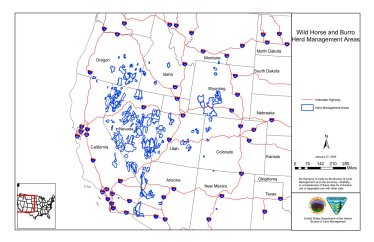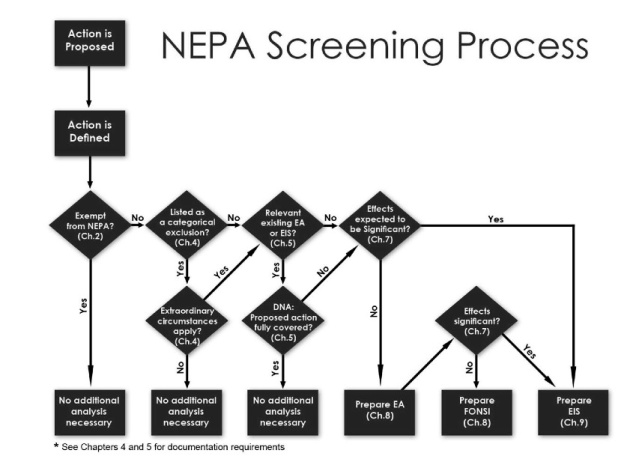When the Bureau of Land Management (BLM) puts out an Environmental Assessment (EA) before a wild horse or burro removal we often see alerts for “public comment” coming from advocacy organizations. These EAs tend to receive a lot of attention. But what are they and where do they fit into process?
An EA is a piece of a larger process. That process is governed by an Act of Congress passed in 1969, National Environmental Policy Act (NEPA).
From BLM website: “Compliance with NEPA is required of all federal actions including adoption of official policy, adoption of formal plans, adoption of programs, and approval of specific projects whether the action is developed by or submitted to the BLM. The NEPA compliance process within the BLM is guided by a series of federal, departmental and bureau laws, regulations and policies.”
Essentially NEPA is the “roadmap” that any proposed action must travel before it becomes actualized. A proposed action is based on frames created through “land use planning,” (LUPs or RMPs).
From BLM website: BLM’s Resource Management Plans (RMPs) form the basis for every action and approved use on the public lands. The BLM prepares RMPs for areas of public lands, called planning areas, which tend to have similar resource characteristics. Planning emphasizes a collaborative environment in which local, state, and tribal governments, the public, user groups, and industry work with the BLM to identify appropriate multiple uses of the public lands. Plans are periodically revised as changing conditions and resource demands require. BLM NEPA handbook HERE.
So simplistically a land use plan will require site-specific management planning for mining, livestock, wild horses, wildlife etc. to be incorporated into a large district wide overview for any proposed action.

BLM map of current herd management areas (HMAs) that have management objectives set through a frame in land use planning.
Once an action is proposed it then steps into this process as outlined in the BLM NEPA handbook (livestock permit, mine, wild horse removal) : Handbook https://www.blm.gov/sites/blm.gov/files/uploads/Media_Library_BLM_Policy_Handbook_h1790-1.pdf
NEPA is a process.
The word that comes before the acronym defines the subject. Example: Gather-EA, gather is the subject and EA was the NEPA process undertaken.
The chart above is the “map” for document preparation. In many instances we will have an underlying EA or Decision that that might allow an action to occur without an additional EA being prepared though what is called a “DNA.” This might transpire under an existing wild horse and burro Gather EA (we are seeing many that now span ten years, not one) or under another document that deals with drought as an example (livestock restrictions or wild horse removals could occur under a drought decision without the need for an additional step). However when there is no existing EA or underlying additional process of NEPA to base an action on, a new EA (or EIS if the scope proposes massive impact) will be prepared.
So at this juncture we usually see the call coming for public comment. Often the public feels frustrated because a comment may receive this response “not appropriate to this EA.” That means that the scope of the comment is not to the proposed action, but to the underlying process of land use planning. BLM tend to skip the open scoping piece for determining what type of NEPA should be done for wild horses/burros and jumping right into the removal plan (skipping any planning for actual management goals).
We know it gets complicated. So the public often relies on organizations to assess these documents for comment.
WHE will continue to provide you with guidelines for submitting comments. However we never want you to blindly agree and always suggest you read supporting links we provide on proposed actions. Then if you agree with our position suggest using our sample comments to create your own letters or simply sign your name to add to the single letter we send.
We hope this information allows you some insight into some of the processes that lead to the management actions surrounding America’s wild horses and burros.
Expect multiple alerts to be coming soon on specific documents requiring your participation. Follow us on FB or Twitter, or subscribe to this site, to receive alerts.

You must be logged in to post a comment.